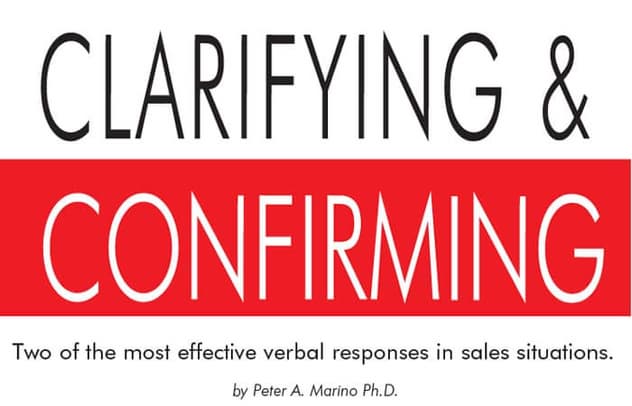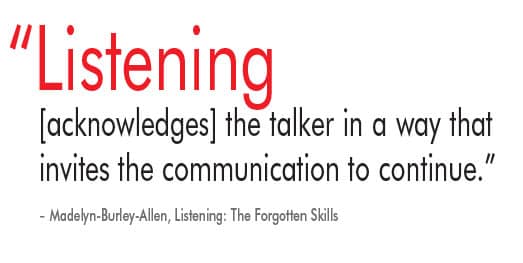
These two sales skills help to demonstrate that the salesperson has respect for the shopper’s thoughts and feelings.
Two of the most effective verbal responses in a sales situation are clarifying and confirming. Each helps to demonstrate to the shopper that the sales associate has respect for his or her thoughts and feelings. Keep in mind owner and author Harvey Mackay’s slightly modified version of Theodore Roosevelt’s saying: “Nobody cares how much you know until they know how much you care.”
Clarifying
Clarifying is a positive way of obtaining a clear, accurate, and complete understanding of what the speaker wants to communicate. Clarifying is especially important when one’s impulse is to reject someone’s idea out of hand. It makes no difference whether the idea rejected is that of a customer, a salesperson, or of any other company employee. Sales managers and salespeople alike need to listen to each other’s ideas, and thrive when they do so. For when they take the time to clarify each other’s ideas, each one feels appreciated, feels in on things, and feel listened to. When that happens, the entire company functions as it ought to. Nothing else can provide the learning climate that active listening does.
Active listeners consistently avoid judging another person’s suggestion without first clarifying to obtain a clear, accurate, and complete understanding of that suggestion.
Open probes invite the speaker to talk freely. In that sense, open probes are non-directive. Closed probes are, however, meant to ‘fence in’ the other person’s communication. Take the example of a customer who tells a salesperson the following: “I’m having a tough time understanding what you mean by this table’s planked solids.” The incorrect response would be, “Before you leave the store today, remind me to give you one of our brochures that’s great at explaining the differences between solid wood and veneers.”
Such a reply is too little and too late. Moreover, that response flies in the face of one of the great Elmer Wheeler’s selling points. “Save ‘em steps.”
Recently while putting on a sales session for a furniture store in Minnesota, I went over Elmer Wheeler’s “Save ‘em steps.” I then mentioned that all things, animate and inanimate, strive to take the fewest possible steps in order to conserve energy. Recently a friend of mine quipped that if you want to find the quickest and easiest way to do something, observe how a lazy individual does it! Shoppers at a mall will risk scraping the paint on their cars to park in a narrow spot, simply because that spot will save them several steps.
Not a week passed and the owner of the Minnesota store called me to tell me that “save ‘em steps” had helped him close a sale. The customer, loved the sleep set, but also wanted to purchase the sheets and pillow case in the same store. The owner’s store happened to be out of those items. Instead of advising her to find them via an internet search, he told her he would do the “leg work” to find out where she could get the best buy on the sheets for quick delivery. He added he would get back to her on that very day. Following up, he found a store that had excellent sheets and pillow cases in stock for a modest delivery price. She ordered them online and purchased the store’s premium sleep set, their most expensive. “Peter,” the owner told me on the phone, “Wheeler’s “save ‘em steps” made the sale.” Amazing what a little clarifying can do for the salesperson and the customer!

The skill of clarifying works best when the salesperson values a customer’s suggestions, ideas, and requests because it becomes easier to resist rejecting those statements out of hand, and so follow up appropriately.
Salespeople who fail to clarify customer statements that require qualifying, end up assuming incorrectly that they understand their customer’s concerns. As a result, the customer may sense that the salesperson is not sincerely interested in understanding him or her.
Confirming
The purpose of clarifying is to arrive at a clear, accurate, and complete understanding of the speaker’s words. Confirming is the skill by which listeners use a closed probe to test if they truly understand the speaker’s logical and emotional content. Confirming is the hand that fits in the glove of clarification. Clarification is a means; confirming is the end. It would make no sense to clarify the speaker’s communication and then leave that clarification unconfirmed.
One other thing: confirming is not agreeing. Also, unlike acknowledging, confirming is not restricted to dealing with the emotions or sentiments of the speaker.
Confirming benefits both the speaker and the listener:
1. It confirms a mutual understanding between the speaker and the listener.
2. It lets the speaker know he or she has truly been listened to because it includes both the speaker’s logical and the emotion content.
3. It makes allowances for the listener’s possible misunderstanding of the speaker’s words.
4. In doing so, confirming demonstrates the listener’s humility.
5. It allows the speaker to add new information he or she may have forgotten to mention.
6. It demonstrates to the speaker that the listener cares, therefore, it helps to establish rapport and trust.
7. The best confirming paraphrases the gist of what the customer has said, but never echoes it.
8. The listener confirms only that part of the speaker’s communication that needs to be confirmed.
9. The listener never confirms the obvious.
An effective way to confirm the speaker’s communication is to use words like the following: “Let’s see if I have this right.” Those words are a concession to the speaker that the listener may not have it “right.” Should the listener’s confirming reveal that the listener did not have it right, the speaker is ready to forgive the listener. How different the speaker would have felt had the listener said, “I’m sure I heard you right.” Instead, by saying, “Let’s see if I have this right,” the speaker tends to be more forgiving, should the listener’s confirmation turn out to be faulty. At times, confirming causes the speaker to remember something he or she had not mentioned. Thus the listener receives further relevant information that would otherwise have been omitted. Let’s take a look at open and closed probes. That’ll make more sense, now that we have actually seen both probes demonstrated.

Whenever the listener would like to encourage the speaker to talk freely or to elaborate on something he or she has said, the listener should use an open probe. Earlier we mentioned that open probes are non-directive, closed probes are directive. Unlike closed probes, open probes don’t fence the speaker in. Because of their nature, open probes work better than closed probes to start the clarifying. Instead, closed probes fit in better with confirming. The following is a list of some open probes. Note that neither open nor closed probes necessarily end with a question mark.
Sample Open Probes
• Oh?
- I’d appreciate hearing more about this.
- What else is important to you?
- Mind sharing with me why that is important to you?
- What kind of books do you enjoy reading most?
- Why do you think that happened?
- Please describe exactly what happened.
Closed probes limit the range of the speaker’s response. There are four kinds of closed probes: (1) yes/no, (2) alternate of choice, (3) probes to obtain quantifiable information regarding size, number, color, dates, names, location, etc., (4) probes to confirm one’s understanding of something the speaker said. Actually the second and the fourth kinds of closed probes are meant to block a negative (no) answer.
Sample Closed Probes
1. To win a yes or a no.
- Are you interested in having me describe the benefits of fabric protection?
- Has anyone seen Bill today?
2. To provide alternate choices.
- Which of the two do you prefer?
- Do you prefer the table with the planked solid wooden top or the one with the veneered top?
- The blue one or the red one?
- It would help if I knew which manner of payment you preferred.
3. To get quantifiable information (size, date, color, type of material)
- How many chairs would you like with this table?
- How soon will you be requiring delivery?
- How many times has this happened?
4. Confirm your understanding.
- Let’s see if I have this right. You need the sofa and the love seat. You need only one lamp table as well as the cocktail table. Is that it?
- I take it you are ready to make your purchase.
- On the phone you said you’d like to know more about leather before you’d invest in a leather sofa. I’d like to propose we do just that today so that you can make an informed decision. Is that OK with you?
This is a three-step opening ending with a confirmation. At times, some call this a four-step opening, since it starts with a sentence that makes a transition from the ‘small talk to’ the actual opening itself.
5. Review of Confirming.
- It helps the customer and the salesperson to arrive at the same understanding.
- It allows the customer to correct any inaccuracies in the salesperson’s confirming.
- It allows the customer to add information.
- It is an excellent way to practice paraphrasing the customer’s words without mimicking or echoing them.
- It is the logical conclusion of clarifying since it demonstrates to the customer that the salesperson has been listening.
By now it should be quite clear that active listening is a skill that requires more than a willingness to learn. It requires:
- Focused use of one’s mind, ears, and eyes.
Note: Of course, you should always be prepared should the customer take your closed probe as an open probe, and vice versa. For example, let’s say the salesperson asks the customer, “What kind of fabric are you looking for?” The customer interprets that as an open probe, and therefore responds as follows: “That raises a problem between my wife and me. She chooses fabrics based on available colors and patterns. I simply want a fabric that’ll last.” The probe still worked. That’s all that matters.